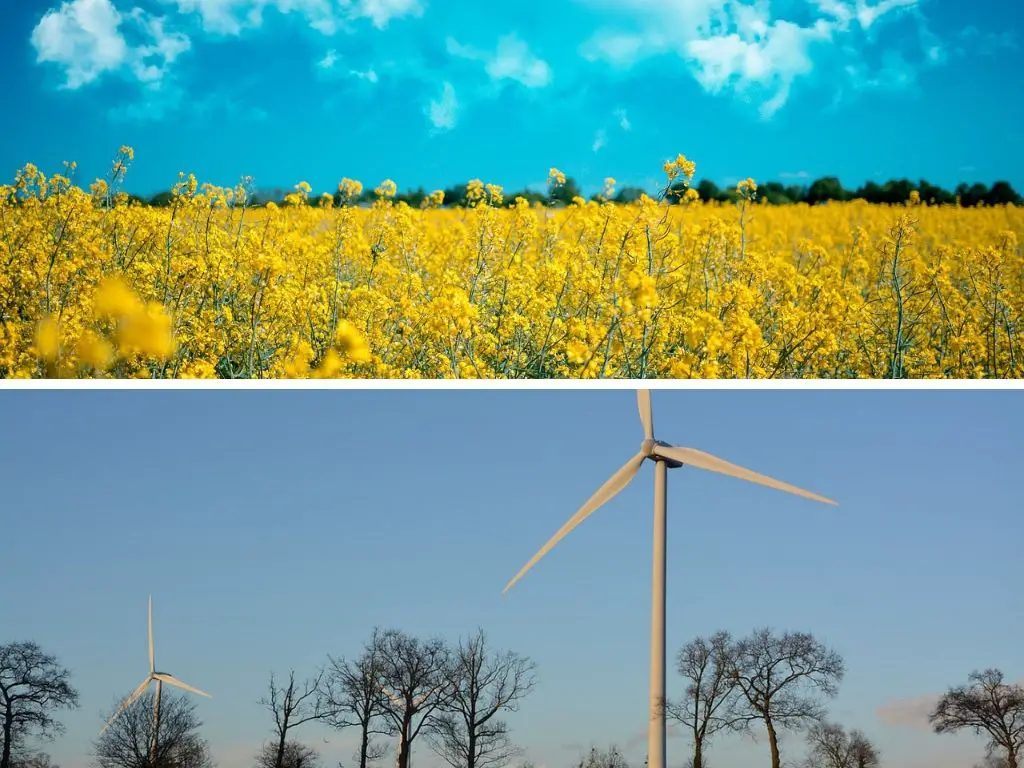Renewable energy is sometimes referred to as sustainable or green energy.
In the guide below, we explain what each of renewable energy, sustainable energy, and also green energy are, along with what the main difference between the these categories of energy might be.
What Is Renewable Energy?
We put together a separate guide where we describe what renewable energy is, and provide information on different aspects of renewable energy.
Renewable energy might generally be described as energy that comes from resources that are either infinite, or, are replenished faster than they are consumed.
What Is Sustainable Energy?
Definitions for sustainable energy might vary.
Sustainable energy might be a broad term that can be used to describe energy sources that have one or more sustainable features.
We’ve previously provided a general definition of sustainability in this guide.
This definition of sustainability might be applied to different aspects of different energy sources i.e. sustainable energy sources might be energy sources that can be sustained or maintained, whilst considering the needs of both present and future generations.
Sustainable energy may even sometimes extend to things outside of energy sources themselves, such as increased energy efficiency (of energy technology, building designs, etc), reducing total energy use, and so on.
What Is Green Energy?
Like sustainable energy, the definitions for green energy might vary.
Some reports may refer to renewable energy as being ‘green energy’, but, green energy might be a broad term that can be used to describe energy sources that have one or more green features.
‘Green’ might refer to the energy source being envrionmentally friendly in some way i.e having minimal negative impact on the environment, or helping preserve the environment.
Assessing The Entire Lifecycle Of An Energy Source
The entire lifecycle of an energy source might be assessed to identify where and how it might be sustainable or green.
Some of the key lifecycle stages for an energy source might include:
– The Extraction/Mining Of Resources
– Refinement/Processing, Manufacture, Or Construction
What resources or materials are required, and what’s the environmental impact?
– Operation/Energy Generation
Is there any air pollution or emissions, or other types of environmental impact?
– Waste Stage
Are there any waste by-products produced as a result of the operation stage?
Categorising Different Energy Sources As Renewable, Sustainable &/Or Green
Not all renewable energy are completely sustainable or green (there may be non-sustainable or non-green features to some renewable energy sources)
And on the flip side, not all sustainable or green energy sources are renewable
We provide some examples of the above points further below …
Renewable Energy Sources That Might Not Be Completely ‘Sustainable’ Or ‘Green’
Some renewable energy sources may not be completely sustainable or green energy sources.
Some examples of this might be:
– Solar Energy, & Wind Energy
Solar energy and wind energy require resources and materials to make solar panels and wind turbines, and so does support equipment like energy storage batteries.
Both also use fossil fuels for various applications
– Hydro Energy
Some pumped hydro storage projects use fossil fuels to pump water up elevations
– Geothermal Energy
Geothermal energy releases methane and has an emissions footprint where drilling is carried out
– Bioenergy
Different types of biomass can be used for bioenergy and other bio-applications.
But, some might argue that some types of bioenergy aren’t fully sustainable for various reasons.
One example of this might be biocrops that use resources like land (which may have to be be cleared to be used), fertiliser, pesticides, water, etc., and that also have an environmental footprint.
This is not even considering the energy conversion efficiency of turning biomass into energy (biomass in general might be far less efficient than other energy sources when it comes to energy conversion)
There’s also the opportunity cost to consider of what this land could be used for instead of growing bio crops.
Other resources on the questionable eco friendliness or green-ness of biomass, bioenergy and biofuels are ecoinvestor.com.au, birdlife.org, and theguardian.com
Energy Sources That Are Sustainable Or Green In Some Ways, But Not Renewable
Some energy sources can be sustainable or green in some ways without being a renewable energy source.
One example of this might be:
– Nuclear Energy
Nuclear energy is a non-renewable energy source, involves the mining of uranium, and results in nuclear waste after the operation stage.
This may make nuclear energy sustainable or green during the operation stage.
What Are Alternative Energy Sources?
Alternative energy might be described as a form of energy that is different from the conventional energy that is used in a particular sector.
It doesn’t necessarily have to be renewable, or completely sustainable or eco friendly.
One example of alternative energy might be a hydrogen fuel cell car which uses hydrogen and fuel cells, instead of petroleum based fuel and a conventional combustion engine.
Sources
1. Various ‘Better Meets Reality’ guides
2. http://www.ecoinvestor.com.au/Articles/Producing-Eco-Friendly-Bioenergy.htm
3. https://www.birdlife.org/europe-and-central-asia/news/why-bioenergy-actually-bad-our-planet
4. https://www.theguardian.com/environment/2015/jan/29/biofuels-are-not-the-green-alternative-to-fossil-fuels-they-are-sold-as
','' ); } ?>